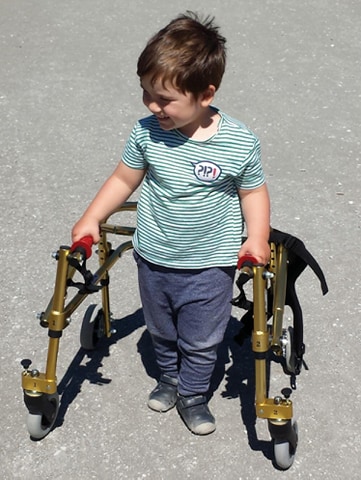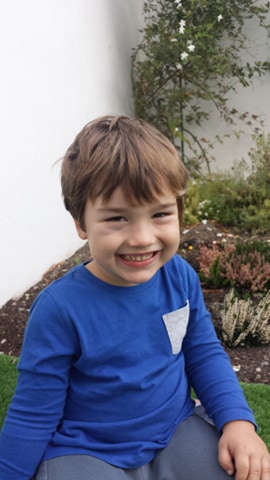Meet Mario, a four-year-old KIF1A superhero from Spain. His mom recounts their journey to finding a diagnosis and says, “His genetic imperfection defines some of his characteristics but it does not hide him as a person.”
A Message from Mario’s Family:
I have two sons, Mario and Alejandro. Mario is four years old and he is perfect with his imperfect mutation. He is a shining fish of almond eyes, crystal clear smile and golden skin. Alejandro is the constant engine that fuels Mario’s steps. His main teacher and his best therapy.
The first months of Mario’s life passed with apparent normality, although during the day he seemed to be of a very calm nature, and at night, there was no way of comforting him. The motor milestones started to be delayed: turning, sitting down, crawling… and little by little, we started to realize that his muscle tone was low, not seriously, but that his small body was softer and more elastic than those of other children. He appeared to be slightly behind also in other areas, such as speech and cognitive aspects, although they were not as pronounced as the motor disability. Otherwise, Mario has always been a very affectionate child, with a very happy character and with no other relevant health issues.
When he turned sixteen months old, the first studies arrived: basic analysis, brain resonance and molecular karyotype were carried out. More than one hundred genetic syndromes and many other alterations were discarded. Whilst initially anxious we had the hope that we were dealing with a mere maturative delay, a condition without surname, acronyms, or capital letters. So we continued with our routine, our therapies, our activities for stimulation, hoping that we would continue on a “normal” path if only a little slower.
Typically, after days, weeks of improvements, a new stagnation would appear, and although he managed to keep his rag doll body standing up and move holding onto the furniture and walls, he did not manage to walk by himself. There were so many falls, crashes and bruises on this delicate skin of a fragile child. So that, again, after two more years, another set of analysis, spinal tap, electromyogram and ophthalmologic explorations were carried out. Needles thrust here and there, which he took very badly. Studies continued to offer no answer, but we started to sense that we were starting to lose the way. That sooner or later we would find another path, another route, that was currently hidden from us.
Something very difficult in this improvised journey has been to walk in the dark for months on end, without really knowing what was Mario’s problem. I have lost track of how many rare diseases we have studied and how many potential diagnoses came through our minds. However, none of these potential syndromes, which were associated with hypotonia, seemed to fit with the characteristics of our son.
Finally, at the age of two years and ten months, we decided to do a whole exome sequencing, a sequencing of that part of the genome which codifies the proteins. In this way, we discovered that the mutation of a gene, called KIF1A which participates in the neuronal nerve conduction, was associated with Mario’s problem. There were less than two hundred known cases in the world with this specific alteration and, in many of these children and youngsters there appeared to exist a progressive and degenerative evolution.
The first days after the diagnosis were really painful. Such a rare diagnosis is difficult to take in, and above all to confront a problem that will get worse with time and for which at the moment there is no treatment. On the other hand, we felt some kind of relief. We finally knew what was happening to our golden fish. We would keep on working with him, now that we were aware of what we were up against; we would also find other children with a similar problem and we would fight to promote the research and the diffusion of information on such an unknown disorder.
Now, at the age of 4, Mario is not going backwards, but moving forward. He can not walk by himself, but his stability and coordination have improved enormously. He is as dynamic as any child his age, and he could travel the world, crawling, swimming and riding his red plastic motorbike. Now he even likes to get around with his walker and does it better every time. His use of language continues to increase and also his understanding of the world around him. He is a happy, playful and fun loving child.
This is our present day, notwithstanding any diagnosis. His genetic imperfection defines some of his characteristics but it does not hide him as a person. He is still Mario, with his own, clear personality and his preferences and habits as any other child. The diagnosis is not a label and not always implies the same limits and setbacks. But diagnosis is necessary as it is a tool that allows science to continue to progress. Diagnosis is the door for a chance at treatment.



